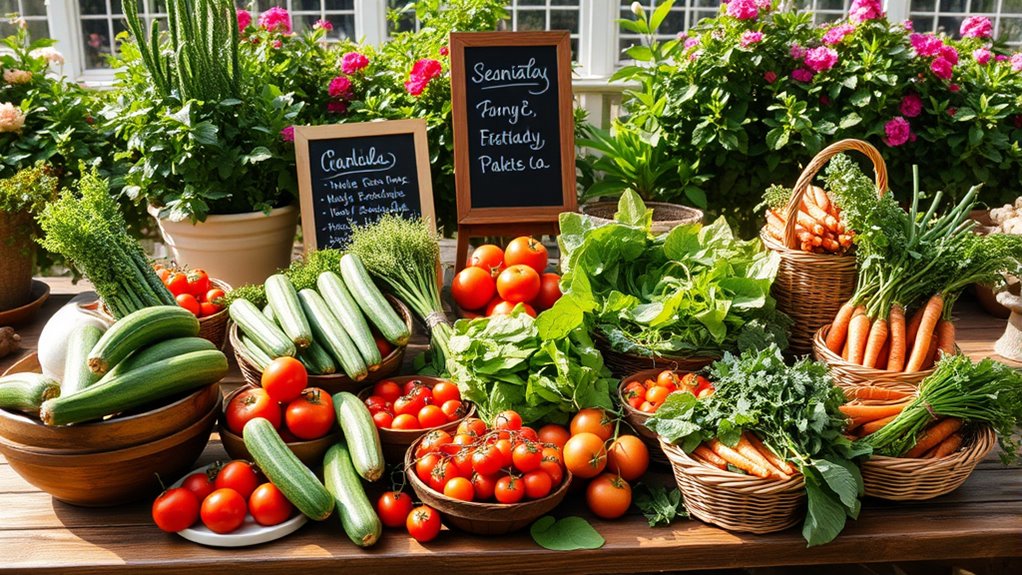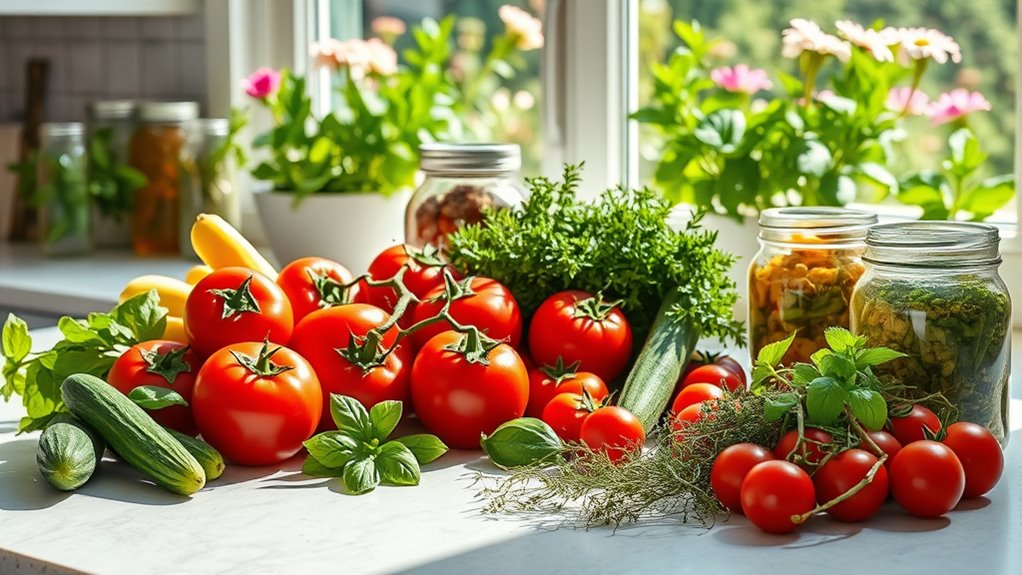To enjoy your garden’s bounty all year, plan a seasonal menu that incorporates preserving techniques like canning, freezing, and drying to extend your harvest. Rotate crops to keep your garden healthy and guarantee a steady supply of different vegetables. By combining crop rotation with preservation, you can create a diverse, flavorful menu every season. Continue exploring practical tips to make the most of your garden’s offerings throughout the year.
Key Takeaways
- Plan menus around seasonal produce, incorporating preserved and stored ingredients for year-round variety.
- Use canning, freezing, and drying to extend harvests and ensure fresh flavors throughout the year.
- Rotate crops in your garden to optimize soil health and maintain a continuous supply of vegetables.
- Combine garden planning with preservation techniques to create a sustainable, dynamic culinary experience.
- Incorporate seasonal ingredients into meals, balancing fresh harvests with stored produce for variety and nutrition.

Have you ever wondered how to keep your menu fresh, exciting, and aligned with what’s in season? The secret lies in thoughtful seasonal menu planning that leverages your garden’s bounty throughout the year. One key approach is preserving harvest, which ensures you enjoy your homegrown produce even when it’s out of season. By preserving, whether through canning, freezing, or drying, you extend the life of your harvest, maintaining the flavors and nutritional value of your crops. This method allows you to incorporate seasonal ingredients into your meals long after their peak, creating a varied menu without relying solely on store-bought produce. Preserving harvest requires planning, but it’s a rewarding way to enjoy the fruits of your labor year-round. Proper preservation techniques can also help retain the nutritional content of your fruits and vegetables, ensuring your meals remain healthy and flavorful no matter the season.
Another essential strategy is crop rotation, a practice that helps keep your garden healthy and productive. When you rotate crops, you prevent soil depletion and reduce the risk of pests and diseases that can wipe out your plants. For example, after growing leafy greens, you might switch to root vegetables the following season. This rotation not only promotes better soil health but also ensures a continuous supply of different vegetables for your menus. When you understand which crops grow best together and rotate accordingly, you’ll have a more reliable and diverse harvest, giving you fresh ingredients to incorporate into your seasonal dishes. Crop rotation also minimizes the need for chemical fixes, making your garden more sustainable and your meals more organic.
Combining preserving harvest and crop rotation creates a sustainable cycle that keeps your menu dynamic and aligned with the seasons. You’ll be able to plan your meals around what’s in abundance, whether it’s fresh in your garden or stored for later. As you develop your seasonal menu, consider how preserving techniques can maximize your harvest’s longevity, and how crop rotation can improve your garden’s productivity. This integrated approach ensures you’re always working with the freshest ingredients, reducing waste, and enjoying a variety of flavors throughout the year. Plus, it deepens your connection to your food, making each meal a celebration of your garden’s cycle. With these methods, you turn your garden into a year-round source of inspiration, flavor, and sustainability, transforming your kitchen into a hub of seasonal culinary delights.
Frequently Asked Questions
How Can I Extend My Garden’S Harvest Into Winter?
To extend your garden’s harvest into winter, you can use greenhouse techniques to protect your plants from cold. Start crop succession by planting fast-growing vegetables like lettuce or radishes before the cold sets in. Cover tender crops with row covers or cloches, and consider installing a small greenhouse or cold frame. These methods help you enjoy fresh produce longer, even when outdoor temperatures drop.
What Are the Best Storage Methods for Seasonal Produce?
Think of your produce as treasure waiting to be opened. To preserve your seasonal bounty, explore dehydrating techniques to turn fruits and herbs into lasting snacks. For root vegetables, a cool, dark root cellar keeps them fresh like a hidden vault. Proper storage methods guarantee your garden’s gifts remain vibrant and tasty, so you can enjoy the flavors of your harvest long after the season ends.
How Do I Plan Menus for Off-Season Gardening?
When planning menus for off-season gardening, you focus on crop rotation to prevent soil depletion and maintain soil fertility. You can extend your garden’s productivity by choosing hardy, cold-tolerant crops or planning indoor planting. Incorporate preserved produce from your harvests, and consider growing in raised beds or containers. This way, you keep fresh ingredients available year-round, ensuring your menu stays diverse and nutritious despite seasonal changes.
Which Crops Are Easiest for Beginner Seasonal Planning?
Think of beginner crops as your garden’s steady drumbeat. Leafy greens like lettuce and spinach are easy starters—just sow, water, and harvest. Tomatoes and radishes are forgiving, making them great for learning crop rotation and companion planting. Carrots and beans also fit well, helping you build confidence. These crops are resilient, simple to grow, and set a solid rhythm for your seasonal planning journey.
How Can I Preserve Herbs for Year-Round Use?
To preserve herbs for year-round use, you can try herb drying or freezing herbs. First, harvest herbs at their peak, then hang them upside down in a warm, dry place for herb drying. Alternatively, chop herbs and freeze them in ice cube trays with water or olive oil. Both methods lock in flavor and aroma, so you can enjoy fresh herbs anytime, no matter the season.
Conclusion
By planning your meals around each season, you can enjoy fresh, flavorful produce year-round and reduce waste. Did you know that eating with the seasons can cut your grocery bill by up to 30%? Not only will you save money, but you’ll also support local farmers and enjoy a diverse diet. So, get your garden ready and embrace seasonal menu planning—you’ll love the variety and freshness it brings to your table all year long.










